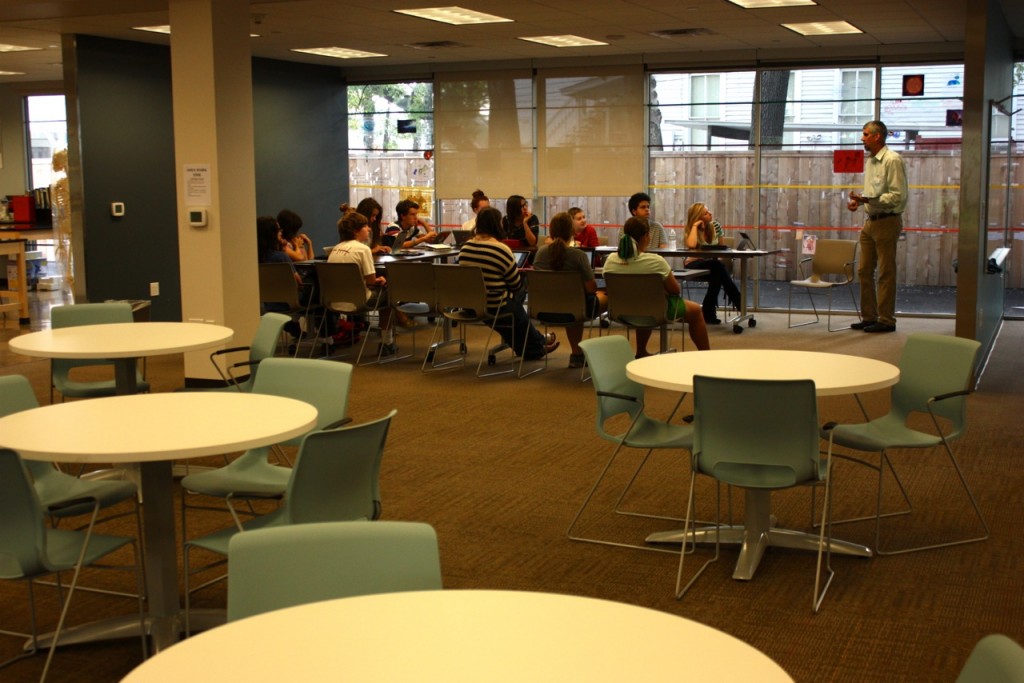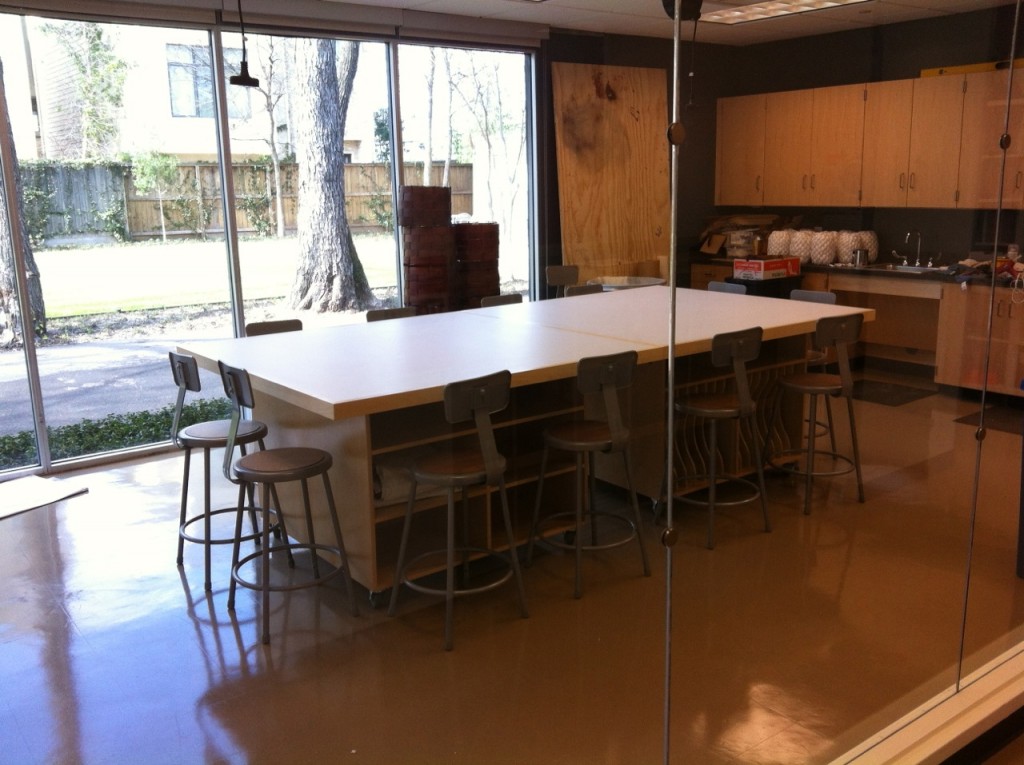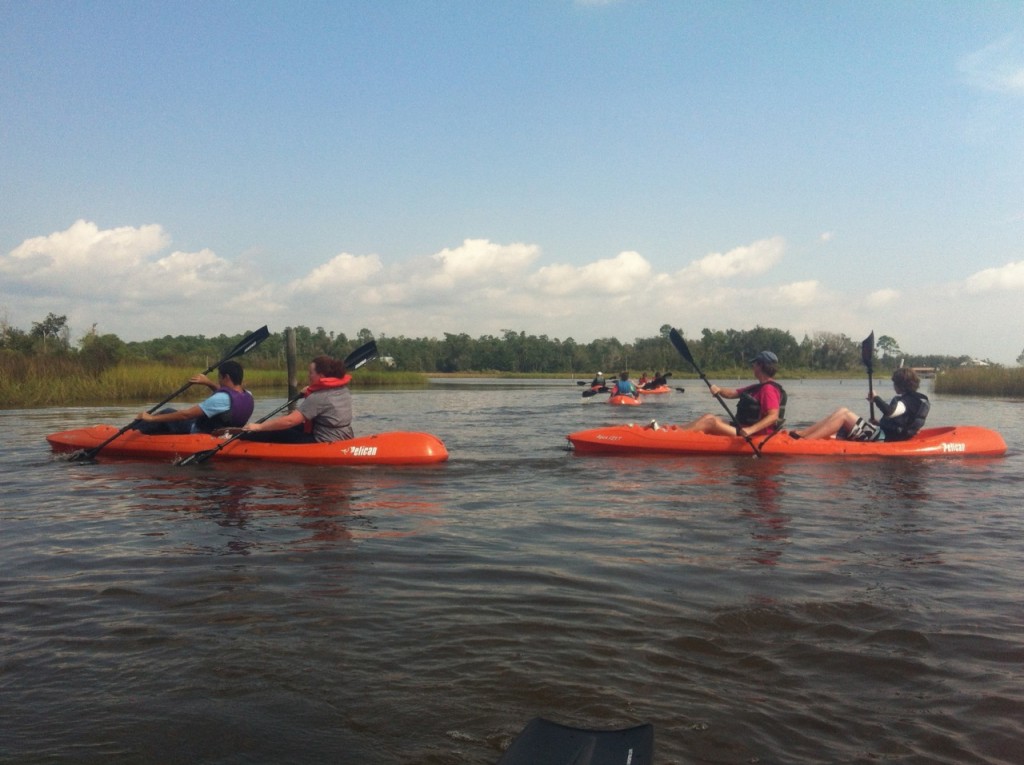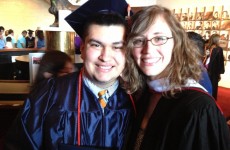When you first walk into the Museum District’s Post Oak High School, little is hidden, including the teachers. The school, a single story, 6,000 square foot brick and glass-walled structure with an open-concept floor plan, was designed with the third teacher in mind. The third teacher is not a human being but the physical space in which we learn.
Before finalizing their design plans for the high school’s 2012 debut, administrators surely asked themselves: how can we shape an educational environment to encourage children to be curious, engaged, and passionate? During my conversations with Post Oak High School Director James Moudry, this question became further nuanced: how can high school students, who crave real, adult experiences, be presented with opportunities from the surrounding environment that help them follow their interests, work through challenges, and discover their strengths?
For Post Oak High School, the answer to this question lies in two arenas: the internal environment of the school and the larger, exploratory playground of Houston’s Museum District.
“Look at your learning space with 21st century eyes: Does it work for what we know about learning today, or just for what we know about learning in the past?”
Sir Ken Robinson – The Third Teacher (2010)
Post Oak’s unique interior, which consists of several open meeting rooms, a science lab, a “tinkerer’s space” (design studio), and kitchen, is home to surprisingly few doors. In fact, the only doors might be those preventing Houston’s humidity from leaking in and those on the bathrooms—bathrooms which the IB authorization visiting team called the nicest they had ever seen! Because there is no Teacher’s Lounge in the school, teachers are constantly accessible. They can easily check on students, and, conversely, students can easily approach teachers with questions, helping increase a student’s individual level of engagement and sense of autonomy.
The high school curriculum, which builds off earlier Montessori models, was described to me as the “sharpening of toolsets” by Moudry. Moudry’s passion for Montessori education is immediately evident; in addition to his 18 years in education, he holds a master’s degree in Montessori. Rather than simply lecture, teachers at Post Oak help students reach a goal and come to answers themselves. To create a challenging, engaging learning environment for students, Moudry has taken great care to shape the curriculum so that students are not left uninspired with barely tolerable busywork but instead presented with “options that are clear paths toward adulthood and that support and challenge.”
The Post Oak learning environment is student-centered, filled with choices, rooted in the real world, activity-focused, and fosters independence. In addition, the curriculum will soon be complemented by the addition of the IB Diploma Program, a widely-recognized two-year intensive program emphasizing global citizenship and focusing on the application, rather than merely the acquisition, of knowledge.
According to Bert and Regina Mellinger, the parents of a current sophomore, the lack of walls serve not only to remove a traditionally hierarchical environment between adults and students but also help to blur the boundaries between various academic disciplines, people, outside places, and opportunities. At schools where teachers and students exist in more isolated surroundings, the Mellingers have noticed a stronger tendency toward the formation of cliques. At Post Oak, students are seldom separated by physical barriers and frequently work on projects collaboratively. Their son, who will be in Post Oak’s first graduating class, has gained a strong ability to work in a team and communicate clearly.
Students are taught that learning does not stop at a school’s wall. Houston’s Museum District exists as the school’s “larger classroom.” Students walk to the nearby Glassell School of Art for their art classes and do research at city libraries as well as those of the nearby University of St. Thomas and Rice University. Students also benefit from partnerships with the Museum of Fine Arts, the Museum of Natural Science, the Contemporary Arts Museum, and the Houston Zoo. For the Mellingers, the Museum District partnerships “reinforce that everything can be a learning environment” and help students become “lifelong learners.”
At Post Oak, students are given the space to invent themselves and encouraged to become the architects of their own studies. Students have opportunities to influence their programs of study through internships and J-Term (a multi-week, thematic group project in January).
Through internships, students can train with experts who are currently working in their field, rather than teaching in it. Some 9th and 10th grade students (the only grades open at this time) have already begun taking advantage of the Museum District Partnerships. There are currently internships in which students are doing research at Houston’s Museum of Natural Science in paleontology, marine biology, and butterfly-centered entomology. Moudry expects the number of internships will increase as the current students move on to 11th and 12th grade.
Another unique component of the Post Oak education is the January “J-term,” in which students have the opportunity to participate in one of several short-term courses designed in conjunction with faculty. During November and December, students make suggestions based on topics they would like to pursue. The courses combine student research, lectures from experts, field trips, and a final assessment. This past January, students were able to elect to either convert an old, cheap gasoline car into an electric car or volunteer and learn history in Jamaica.
Our education system should more frequently reflect real world scenarios. Subjects do not exist in isolation. With the world globalizing at an ever increasing rate, we, as teachers, must stress interconnectedness and motivate our students toward the infinite possibilities before them.
———————————————————
Post Oak High School is a secondary campus of Post Oak Montessori (K-12), the oldest Montessori school in the Southwest United States, located just off US-59 in the Houston Museum District. The original campus, which serves Pre-K – 8th grade students, is located roughly 4 miles away in Bellaire. As the high school opened recently, there are currently only 9th and 10th grade students. They expect to eventually have 120 students between the four grades. For more information, interested parties should contact the Admissions Director, Vivian Blum, at vivianblum@postoakschool.org or visit www.postoakschool.org.
About the Author: Jane Manchon spent a year teaching English in Thailand under the auspices of the Fulbright Program after graduating from Vassar College (’11) with a degree in International Studies and minor in French. Jane grew up in Houston and was valedictorian of Westside High School (’07), a National Merit Finalist, and a National AP Scholar. She served as General Academic’s Communications Manager from December 2012 to January 2014.



















Pingback: Most Researched Schools on Houston School Survey